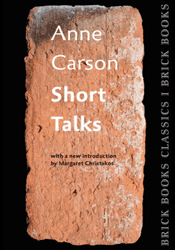
What is it about Anne Carson’s poetry that opens us up? That asks us, as readers, to respond? The first time I read Anne Carson’s work I was 22 years old and madly escaping the overwhelming stimulus of New York City for a weekend in the belly of a silver, Greyhound bus bound for Pennsylvania. Every page I read in Glass, Irony and God seemed to lift up off the page and shout words back directly into my mind; words that I wrote down in every crack of white space each page had to offer. It was as if while reading Anne Carson, a new mind inside my mind had been peeled back and revealed. Ever since that day, I’ve read everything by Anne Carson I could get my hands on. And every time I read her, I again am met with the same reaction. It wasn’t until I began working on my dissertation years later and found myself reading the work of ancient Greek poets like Sappho that I began to better understand the tradition in which Carson is writing. It’s a tradition of writing in a way that creates for the reader a space to think, to insert his/her experiences into the gorgeous form the poem has offered. It’s the reason why writers have been writing back to Sappho for centuries (think Amy Lowell’s “The Sisters” and H.D.’s poems written off of fragments of poems by Sappho). Somehow, Anne Carson’s poetry, like Sappho’s, allows us to split open so that we can hear the better writer inside ourselves.
Short Talks, which was first published in 1992 by Brick Books and was recently reissued, is no exception. The book is made up of a series of lyric prose poems written in a voice that is both self-less and indirect at the same time; A voice that it is deeply personal, yet remains hard to recognize. In these poems, Carson’s voice reaches in like a light in a velvety dark room. Each prose poem is on a different topic. As Margaret Christakos, who wrote the introduction to the new edition so succinctly states, “each poem wakes up to a new voice.” And these voices, that are written beyond the fences of genre, are both “private and profusely choral” at the same time.
In her poem “Introduction” Carson begins the book by immediately shifting the Teutonic plates beneath the reader’s feet by taking away the meaning of what we rely on for sense in a book: words. As she writes, “Early one morning words were missing. Before that, words were not, Facts were, faces were.” She reminds us that “Aristotle tells us, everything that happens is pushed by something else”. Indeed, the poems that follow each look at something (Homo Sapiens, Geisha, Gertrude Stein, Ovid in exile and Sylvia Plath) in order to understand how that person, place of thing has pushed by something else. She writes about things from all sides but straight on in order to understand this inheritance. It is in this space, the gap between what is known and what is not yet known, that the words are found. The place where the blind storyteller has to continue on past what is known using only his or her senses.
In “Short Talk on Chromo-Luminarism” Carson uses this technique to look behind what is known of George Seurat’s famous painting A Sunday Afternoon on the Island of La Grande Jatte in order to understand the painting’s epic, canonical pull. As she writes, “Where does a European go when he is ‘lost in thought?” Seurat – the old dazzler – has painted that place…He caught us hurrying through the chill green shadows like adulterers. The river was opening and closing its stone lips. The river was pressing Seurat to is lips.” In a sense she sees in Seurat the longing we feel for the cool, dappled place of uninterrupted thought, as created by the space between points. It is between the tiny points of colored paint, that we find respite because in those spaces we are able to find our own experiences and connect them to what is painted on the canvas.
 Like most Carson books, the poems in this collection also speak back to recorded history, asking to see between the cracks of recorded facts in order to find a new kind of truth. In “Short Talk on Ovid” she imagines what it might have really been like for Ovid once he was exiled to Tomis and he is stranded in the farthest reaches of the Roman Empire, far away from all of his friends and family. “Each night about this time he puts on sadness like a garment and goes on writing” a poem no one will read (Ovid never finished his books of poems written while in exile: Tristia and Epistulae ex Ponto). Or, in “A Short Talk on Sylvia Plath” Carson thinks about how Plath’s mother said “plain burned things on television” about her daughter because she could never understand the complicated language, the words “humming in the middle of air,” that her daughter spoke on the page.
Like most Carson books, the poems in this collection also speak back to recorded history, asking to see between the cracks of recorded facts in order to find a new kind of truth. In “Short Talk on Ovid” she imagines what it might have really been like for Ovid once he was exiled to Tomis and he is stranded in the farthest reaches of the Roman Empire, far away from all of his friends and family. “Each night about this time he puts on sadness like a garment and goes on writing” a poem no one will read (Ovid never finished his books of poems written while in exile: Tristia and Epistulae ex Ponto). Or, in “A Short Talk on Sylvia Plath” Carson thinks about how Plath’s mother said “plain burned things on television” about her daughter because she could never understand the complicated language, the words “humming in the middle of air,” that her daughter spoke on the page.
But at the center of this book, like all of her others that I have read and written copiously in the margins of, is a call back to the reader. Something that opens in the reader a need to answer back; a need to write between the cracks she has left for us to solve. As in her “Short Talk on Shelter” where she informs us “You can write on a wall with a fish heart” because of the phosphorus the fish ingest. She continues with a summoning to the reader to answer back: “I am writing this to be as wrong as possible to you. Replace the door when you leave, it says. Now tell me how wrong that is, how long it glows. Tell me”.
Now, who could read those luminous words and not write back?




